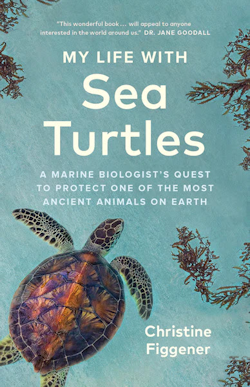SEJournal Online is the digital news magazine of the Society of Environmental Journalists. Learn more about SEJournal Online, including submission, subscription and advertising information.
 |
BookShelf: The Resilient Sea Turtle, Beset by Threats
“My Life With Sea Turtles: A Marine Biologist’s Quest To Protect One of the Most Ancient Animals on Earth”
By Christine Figgener
Translated by Jane Billinghurst
Greystone Books, $28.95
 |
Reviewed by Tom Henry
German-born Christine Figgener admits she was not a likely candidate to become a marine biologist willing to devote her life to researching sea turtles.
Yet somehow, after growing up in a gray industrial town, she noticed an opening on a bulletin board for a work-study program in Costa Rica while in college and, like many young people, was eager to seek out an educational experience in another part of the world.
The decision, she writes, ended up leading to her life’s calling she never knew she had. She’s now convinced she was put on Earth to be a sea turtle scientist.
This highly intriguing book of hers, as fellow ecologist-author Carl Safina states, is part memoir and part field guide.
Figgener does a fine job of explaining the spectacular beauty and resilience of sea turtles in a way that promotes more empathy for them without getting too emotional.
I certainly came away with a better appreciation for them. How many people know, for example, that the leatherback turtle can grow to be as large as 1,320 pounds? Think about it. That’s more than a half ton of turtle, folks.
Readers also can come away with a better appreciation for how tough turtles are. Figgener describes how, even after undergoing trauma, a mother turtle with only one functional flipper will find a way to scoot up a beach to lay her eggs.
Turtles are another one of those amazing creatures in nature that, while resilient, exist to some degree out of sheer luck. The high mortality rate of thousands and thousands of baby turtles that head to the ocean, with only a few surviving long enough to outlast predators and other issues to live into adulthood, is pretty amazing.
For underwater eaters, the perils of plastic
Yes, Figgener has some clarion calls about climate change. But in several parts of the book, she describes how society’s ubiquitous affair with plastics has become a lethal danger to turtles. That includes microplastics and nanoplastics.
One thing I’d never considered: how turtles eat underwater.
“Over millions of years of evolution, sea turtles have successfully mastered the art of eating underwater without swallowing mouthfuls of sea water,” she writes.
Figgener describes the process as one in which a sea turtle’s esophagus is covered with keratinized spines oriented toward the stomach. Food gets impaled on the spines and stays put as the turtle ejects the seawater, mostly through its nose.
What was once an evolutionary advantage
is now a disadvantage because plastic
gets caught in those same spines.
But what was once an evolutionary advantage is now a disadvantage because plastic gets caught in those same spines.
“For many years now, plastic in the stomachs of sea turtles has been an unhappy part of their everyday lives and the everyday lives of sea turtle researchers, who have been finding plastic bags in the stomach of leatherback turtles since the 1970s and 1980s,” she writes.
To a turtle, a plastic bag looks like a jellyfish. It thinks it’s food. Studies show that plastic even smells like food to them. Turtles die a slow, agonizing death from starvation when they get too much plastic in their esophagus spines and their stomachs. It can harm or destroy their intestinal tracts, and they can’t absorb food like they should.
Viral video experience an eye-opener
Figgener also has some astute observations about the roles of science communication and social media in our ever-changing and unpredictable journalism landscape.
She writes how her moment of fame came when she filmed the removal of a plastic straw from the nose of an olive ridley turtle in 2015.
“Thanks to this one video, I acquired an eclectic mix of skills that had nothing to do with science, ranging from expertise in copyright issues and social media marketing to unconventional methods of fundraising,” Figgener writes.
“I probably also got a thicker skin from having to deal with blunt anonymous and not-so-anonymous criticism, and rude and ignorant remarks,” she adds. “Nameless internet users attacked me, as did powerful lobbyists who made outrageous claims as they attempted to drag my name and my video through the mud.”
Figgener says the most important takeaway is that scientists “need to communicate our findings in a more effective way.”
“Rather than simply publishing them in scientific journals, we need to use social media and the press,” she adds, admitting many of them are not good at that.
Ocean denizens face ‘utterly overwhelming’ threats
Figgener writes with passion and a sense of purpose. She explains how being a sea turtle researcher is not at all glamorous; many who gather in Costa Rica for such arduous work spend months away from their homes in other parts of the world.
They walk as many as seven miles across beaches each night, have little or no access to transportation, and may live weeks on beans and rice. Only in recent years has there been more internet access to help them remain connected to other regions.
She mentions other problems such as coastal development, sea level rise and how overuse of agricultural fertilizers has resulted in dead zones and algal blooms. She explains the controversy behind turtle soup and how illegal harvesting of turtle eggs and poaching was a huge problem in years past.
In one community, she writes, farmers literally used to bring hogs out on the sandy beaches to fatten up on turtle eggs until the practice was banned.
‘The inhabitants of our oceans are
beset by threats that appear
to be utterly overwhelming.’
“The inhabitants of our oceans are beset by threats that appear to be utterly overwhelming,” Figgener writes.
Her epilogue contains a sobering thought.
“Sea turtle numbers across the globe are declining, and many populations are 80 to 90 percent smaller than they used to be. A few populations, such as the leatherback population in the Eastern Tropical Pacific, are literally on the brink of extinction,” Figgener writes. “It pains me to think that in the not too distant future, these magnificent mother turtles may no longer be visiting my beloved Pacific beaches.”
Her book isn’t perfect, yet it was good enough to get a plug from none other than Jane Goodall.
But, like a lot of us, Figgener doesn’t own a house in a fancy new neighborhood with an expensive sports car in the driveway.
Perhaps we all should “start defining success differently,” Figgener writes.
“For my part, I will die content if I know I have achieved something positive in my life,” she adds.
Tom Henry is SEJournal’s BookShelf editor, a former board member for the Society of Environmental Journalists and created The (Toledo) Blade’s environment beat in 1993. His last review was of a volume by renowned birder Kenn Kaufman.
* From the weekly news magazine SEJournal Online, Vol. 9, No. 43. Content from each new issue of SEJournal Online is available to the public via the SEJournal Online main page. Subscribe to the e-newsletter here. And see past issues of the SEJournal archived here.













 Advertisement
Advertisement 



